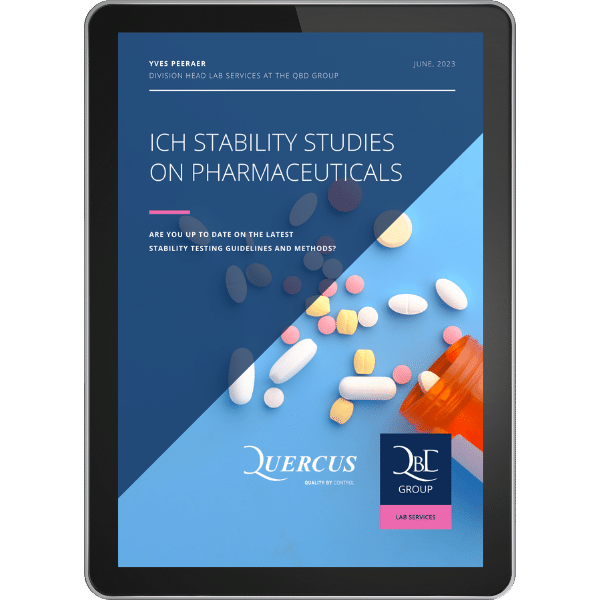The International Council for Harmonization of Technical Requirements for Pharmaceuticals for Human Use (ICH) has developed guidelines for testing the stability of pharmaceutical products. The ICH guidelines provide a standardized approach to stability testing in various regions, including the United States, Europe, and Japan.
By following the ICH guidelines and considering key factors that can affect stability, pharmaceutical companies can develop high-quality products that meet regulatory requirements and patient needs. In this blog post, we provide a brief overview of the most important guidelines and what they entail.
FREE WHITEPAPER
ICH Stability Studies on Pharmaceuticals
Are you up to date on the latest stability testing guidelines and methods? This whitepaper discusses the importance of different methods for testing the stability of pharmaceutical products, stability study guidelines, and other aspects related to the stability of pharmaceutical products.
ICH guidelines: quick overview
ICH Q1A
ICH Q1A provides general principles for the stability testing of new medicinal product substances and products. The guideline outlines the minimum testing requirements, including the selection of storage conditions, sampling plan, and testing frequency. The guideline also provides recommendations on the acceptance criteria for stability data and the duration of stability testing.
ICH Q1B
ICH Q1B provides specific recommendations for the photostability testing of new medicinal product substances and products. The guideline outlines the test conditions, light sources, and data analysis requirements for photostability testing.
Normally, photostability testing is carried out on a single batch of materials selected as described under ‘Selection of Batches’ in the Parent Guideline.
Under some circumstances, these studies should be repeated if certain changes are made to the product (e.g., formulation, packaging).
ICH Q1C
ICH Q1C guideline describes the requirements for stability testing of new dosage forms. Stability protocols for new dosage forms should follow the guidance in the parent stability guideline in principle. However, a reduced stability database at submission time (e.g., 6 months accelerated and 6 months long-term data from ongoing studies) may be acceptable in certain justified cases.
ICH Q1D
ICH Q1D describes bracketing and matrixing study designs. It defines specific principles for situations in which bracketing or matrixing can be applied. Sample designs are provided for illustrative purposes.
ICH Q1E
ICH Q1E addresses the evaluation of stability data that should be submitted in registration applications for new molecular entities and associated medicinal product products. The guideline provides recommendations on establishing retest periods and shelf lives for medicinal product substances and medicinal product products intended for storage at or below room temperature.
ICH Q1F
ICH Q1F addresses stability testing in countries located in Climatic Zones III (hot and dry) and IV (hot and humid), i.e. countries not located in the ICH regions and not covered by ICH Q1 A
ICH Q5C
ICH Q5C covers the generation and submission of stability data for well-characterized proteins and polypeptides, their derivatives, and products of which they are components, and which are isolated from tissues, body fluids, cell cultures, or produced using rDNA technology. It may also apply to other types of products, such as conventional vaccines, after consultation with the appropriate regulatory authorities.
Additional guidance by regulatory agencies
In addition to the ICH guidelines, regulatory agencies also offer guidance that provides further detail on specific aspects of stability testing.
For example, the FDA’s guidance on stability testing for generic drugs provides recommendations on the number of batches to be tested, the selection of test conditions, and the duration of stability testing for generic drugs.
Regulatory agencies, such as the European Medicines Agency (EMA) and the Japanese Ministry of Health also provide specific guidelines for pharmaceutical stability testing. Still, the guidelines issued by these agencies are consistent with the ICH guidelines and provide additional details on particular aspects of stability testing, such as acceptance criteria, data analysis and documentation requirements.
Conclusion: adherence to guidelines is essential for ensuring stability
In conclusion, adherence to the guidelines established by the ICH is essential for ensuring the stability of pharmaceutical products. These guidelines, which have been widely adopted in regions like the United States, Europe, and Japan, offer a standardized approach to stability testing.
By following the ICH guidelines and considering key factors that influence stability, pharmaceutical companies can develop high-quality products that meet regulatory requirements and address patient needs.
The various ICH guidelines discussed in this blog post, including Q1A, Q1B, Q1C, Q1D, Q1E, Q1F, and Q5C, provide comprehensive instructions on stability testing protocols, photostability testing, stability data evaluation, and more.
It is also important to note that regulatory agencies such as the FDA, EMA, and the Japanese Ministry of Health supplement the ICH guidelines with additional guidance specific to their regions. These agency guidelines align with the ICH guidelines and offer further insights into acceptance criteria, data analysis, and documentation requirements.
By following both the ICH guidelines and the supplementary guidance from regulatory agencies, pharmaceutical companies can ensure the stability and quality of their products, ultimately contributing to the safety and efficacy of medications for patients worldwide.
FREE WHITEPAPER
ICH Stability Studies on Pharmaceuticals
Are you up to date on the latest stability testing guidelines and methods? This whitepaper discusses the importance of different methods for testing the stability of pharmaceutical products, stability study guidelines, and other aspects related to the stability of pharmaceutical products.
Quercus, your trusted GMP Lab
Quercus Laboratories is a member of the QbD group and is a trusted GMP Laboratory that supports the pharmaceutical industry with a wide range of QC testing services. We offer a complete service from chemical and microbiological QC testing of raw materials and finished drug products.
Our capabilities include:
Analytical Method Validation – Batch release – EU Import services – Tech transfers of analytical methods – Batch Testing and Certificate of Analysis – Manufacturing plant certification for EU-GMP compliance – Documentary review – Batch Certificate for release – QP Back-Up Services – Additional stability studies – Secure storage of retention samples – MA holder – Regulatory affairs support: CTD dossier writing and marketing authorization application (CP/DCP/MRP/NP)

